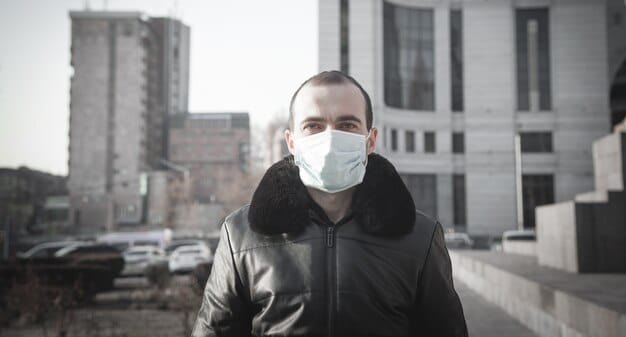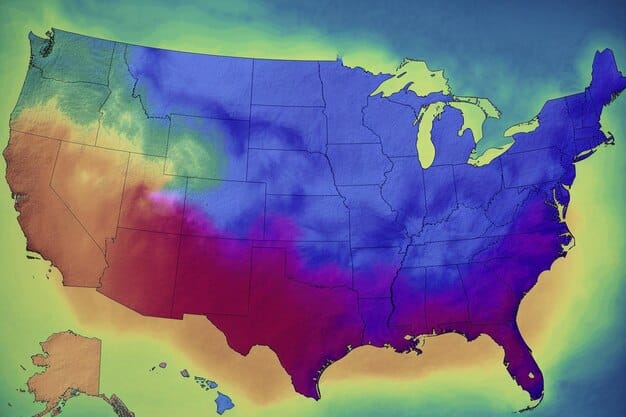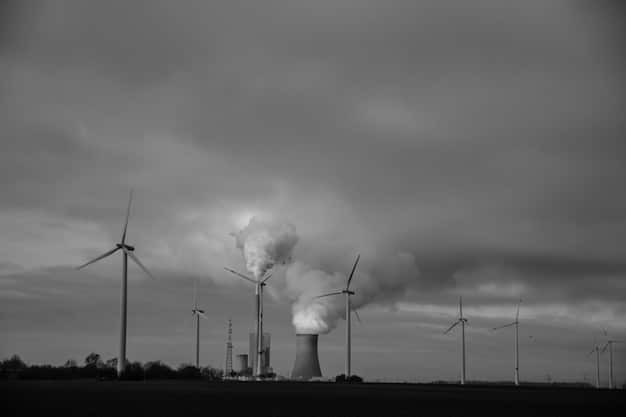Air Quality and Respiratory Health: EPA Findings & Protection

The impact of air quality on respiratory health is significant, and the EPA’s latest findings highlight the urgent need for protective measures to safeguard public health and well-being, especially for vulnerable populations.
Poor air quality poses a significant threat to respiratory health, impacting millions of people across the United States. The Impact of Air Quality on Respiratory Health: EPA’s Latest Findings and Protective Measures reveals the severity of this issue and outlines actions individuals and communities can take to mitigate risks.
Understanding the EPA’s Air Quality Standards
The Environmental Protection Agency (EPA) sets national ambient air quality standards (NAAQS) to protect public health and welfare. These standards define acceptable levels of pollutants in outdoor air. Understanding these standards is crucial for protecting your respiratory health.
Key Pollutants Monitored by the EPA
The EPA monitors several key pollutants that pose risks to respiratory health. These pollutants include:
- Particulate Matter (PM): Fine inhalable particles that can penetrate deep into the lungs.
- Ozone (O3): A gas formed by the reaction of sunlight with pollutants from vehicle emissions and industrial sources.
- Sulfur Dioxide (SO2): A gas released during the burning of fossil fuels, especially coal and oil.
- Nitrogen Dioxide (NO2): A gas produced by vehicles, power plants, and industrial processes.
How the EPA Monitors and Reports Air Quality
The EPA operates a network of monitoring stations across the country to measure pollutant levels. This data is used to calculate the Air Quality Index (AQI), a tool that communicates air quality information to the public. The AQI ranges from 0 to 500, with higher values indicating poorer air quality and greater health risks.

In summary, the EPA’s air quality standards and monitoring efforts are essential for assessing and mitigating the impact of air pollution on respiratory health. Regular monitoring and public reporting enable individuals and communities to take informed actions to protect themselves.
The Direct Link Between Air Pollution and Respiratory Illnesses
Air pollution can trigger or exacerbate a host of respiratory illnesses. Individuals with pre-existing conditions, children, and the elderly are particularly vulnerable. Understanding the direct links between air pollution and these conditions is crucial for preventative care.
Asthma and Air Quality
Asthma is a chronic respiratory disease characterized by inflamed and narrowed airways. Air pollution can trigger asthma attacks and worsen symptoms. Particulate matter, ozone, and nitrogen dioxide are among the chief culprits.
Exposure to high levels of these pollutants can lead to increased coughing, wheezing, shortness of breath, and chest tightness. Long-term exposure can also increase the frequency and severity of asthma attacks.
COPD and Air Pollution
Chronic Obstructive Pulmonary Disease (COPD) is a progressive lung disease that includes chronic bronchitis and emphysema. Air pollution can significantly worsen COPD symptoms and accelerate disease progression.
Pollutants like particulate matter and sulfur dioxide can inflame and irritate the airways, leading to increased mucus production, coughing, and shortness of breath. Prolonged exposure can also increase the risk of exacerbations and hospitalizations.
Other Respiratory Infections
Air pollution can also increase susceptibility to respiratory infections such as bronchitis and pneumonia. Pollutants can impair the immune system’s ability to fight off infections and damage the respiratory tract, making it easier for pathogens to invade.
In conclusion, the direct link between air pollution and respiratory illnesses highlights the importance of reducing exposure to pollutants. Strategies such as using air purifiers, avoiding outdoor activities during high pollution days, and advocating for cleaner air policies can significantly improve respiratory health.
EPA’s Initiatives for Cleaner Air: A Detailed Overview
The EPA has implemented several initiatives aimed at improving air quality across the United States. These initiatives range from setting emissions standards for vehicles and industries to supporting local efforts for air pollution control and remediation.

Setting Emissions Standards
One of the EPA’s primary roles is to set and enforce emissions standards for various sources of air pollution. These standards aim to reduce the amount of pollutants released into the atmosphere.
For example, the EPA has established emissions standards for vehicles that limit the amount of pollutants they can release. Similarly, industrial facilities are required to use control technologies to minimize their emissions.
Clean Air Act and Its Impact
The Clean Air Act is a landmark federal law that regulates air emissions from stationary and mobile sources. The Act authorizes the EPA to establish national ambient air quality standards (NAAQS) to protect public health and welfare.
Since its enactment, the Clean Air Act has significantly reduced air pollution levels across the country. It has led to substantial reductions in pollutants such as sulfur dioxide, nitrogen dioxide, and particulate matter.
Promoting Clean Energy
The EPA promotes the use of clean energy sources to reduce reliance on fossil fuels and lower air pollution levels. This includes initiatives to increase the use of renewable energy sources such as solar, wind, and geothermal power.
The agency also supports energy efficiency programs that help reduce energy consumption and lower emissions from power plants. These programs contribute to cleaner air and a healthier environment.
In summary, the EPA’s initiatives for cleaner air include setting emissions standards, implementing the Clean Air Act, and promoting clean energy. These efforts are essential for protecting public health and reducing the impact of air pollution on respiratory health.
Protective Measures for Individuals: Actions You Can Take
Individuals can take several actions to protect themselves from the adverse effects of air pollution. These measures include monitoring air quality, using air purifiers, and adjusting outdoor activities based on pollution levels.
Monitoring Air Quality
Staying informed about air quality levels is crucial for taking appropriate protective measures. Several resources are available to monitor air quality, including:
- EPA’s AirNow Website: Provides real-time air quality information for locations across the United States.
- Local News Outlets: Many local news stations report air quality levels as part of their weather forecasts.
- Air Quality Apps: Several smartphone apps provide air quality information and alerts.
Using Air Purifiers
Air purifiers can help remove pollutants from indoor air, creating a cleaner and healthier environment. High-Efficiency Particulate Air (HEPA) filters are particularly effective at removing particulate matter.
When selecting an air purifier, consider the size of the room and the type of pollutants you want to remove. Look for models that are certified by the Association of Home Appliance Manufacturers (AHAM).
Adjusting Outdoor Activities
During periods of high air pollution, it is advisable to adjust outdoor activities to minimize exposure. This may include:
- Avoiding strenuous activities: Exercise can increase the amount of air you breathe, leading to greater exposure to pollutants.
- Staying indoors: Staying inside with windows closed can reduce your exposure to outdoor air pollution.
- Wearing a mask: Wearing a mask can help filter out particulate matter and other pollutants.
In conclusion, individuals can take several protective measures to reduce their exposure to air pollution. By monitoring air quality, using air purifiers, and adjusting outdoor activities, you can significantly improve your respiratory health and well-being.
Community Initiatives: How Local Actions Can Improve Air Quality
Community initiatives play a crucial role in improving air quality at the local level. These initiatives range from promoting public transportation to planting trees and supporting local air quality regulations.
Promoting Public Transportation
Encouraging the use of public transportation can reduce vehicle emissions and improve air quality. Public transportation options include buses, trains, and subways. Carpooling and biking are also effective ways to reduce vehicle emissions.
Communities can promote public transportation by investing in infrastructure improvements, offering incentives for using public transit, and raising awareness about the benefits of public transportation.
Planting Trees and Green Spaces
Trees and green spaces can help absorb pollutants and improve air quality. Trees absorb carbon dioxide and release oxygen, helping to reduce greenhouse gas emissions. They also filter out particulate matter and other pollutants from the air.
Communities can promote tree planting by organizing tree planting events, supporting local nurseries, and incorporating green spaces into urban planning and development.
Supporting Local Air Quality Regulations
Supporting local air quality regulations is essential for reducing air pollution and protecting public health. These regulations may include:
- Restrictions on open burning: Burning leaves and other materials can release significant amounts of pollutants into the air.
- Limits on idling vehicles: Idling vehicles can contribute to air pollution, particularly in urban areas.
- Regulations on industrial emissions: Industrial facilities are often subject to regulations that limit the amount of pollutants they can release.
To summarize, community initiatives such as prompting public transportation, planting trees, and supporting local air quality regulations can significantly improve air quality. Collective action at the local level is essential for creating cleaner, healthier communities.
The Role of Technology in Monitoring and Reducing Air Pollution
Technology plays a vital role in monitoring and reducing air pollution. Advances in sensor technology, data analytics, and emission control systems are helping to improve air quality and protect public health and that, in turn, leads to healthier respiratory systems everywhere.
Advanced Sensor Technology
Advanced sensor technology enables more accurate and comprehensive monitoring of air pollution levels. These sensors can measure a wide range of pollutants and provide real-time data on air quality.
Low-cost sensors are also becoming increasingly available, allowing communities to deploy networks of sensors to monitor air quality in their neighborhoods. This data can be used to identify pollution hotspots and inform local air quality management efforts.
Data Analytics and Modeling
Data analytics and modeling tools can help analyze air quality data and identify sources of pollution. These tools can also be used to predict future air quality levels and assess the effectiveness of air pollution control strategies.
Sophisticated models can simulate the transport and dispersion of pollutants, allowing researchers to understand the factors that influence air quality. This information can be used to develop more effective air quality management plans.
In summary, the role of technology in monitoring and reducing air pollution is critical. These advancements lead to increased awareness and in-turn, action. Sensor technology, data analytics, and modeling help provide more detail and are essential for achieving cleaner air. By leveraging the power of technology, we can create healthier and more sustainable communities.
| Key Point | Brief Description |
|---|---|
| 📊 EPA Standards | EPA sets air quality standards to protect public health. |
| 🤒 Respiratory Illnesses | Air pollution exacerbates asthma, COPD, and infections. |
| 🛡️ Protective Measures | Monitor air quality, use purifiers, and adjust outdoor activity. |
| 🌱 Community Action | Promote public transport, plant trees, and support regulations. |
Frequently Asked Questions (FAQs)
▼
The EPA monitors pollutants like particulate matter, ozone, sulfur dioxide, and nitrogen dioxide that pose risks to respiratory health.
▼
Air pollution can trigger asthma attacks, worsen symptoms, and increase the frequency and severity of attacks in sensitive individuals.
▼
Individuals can monitor air quality, use air purifiers, adjust outdoor activities, and wear masks during periods of high pollution.
▼
The Clean Air Act is a federal law that regulates air emissions from stationary and mobile sources to protect public health and the environment.
▼
Communities can promote public transportation, plant trees, support local air quality regulations, and raise awareness about air pollution issues.
Conclusion
The impact of air quality on respiratory health is a critical issue that demands immediate attention and sustained effort. By understanding the EPA’s findings, implementing protective measures, and supporting community initiatives, we can work together to improve air quality and ensure a healthier future for all.





